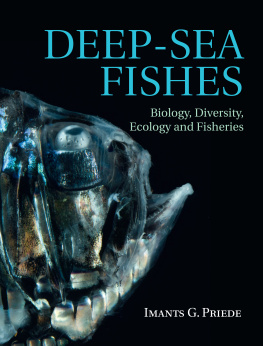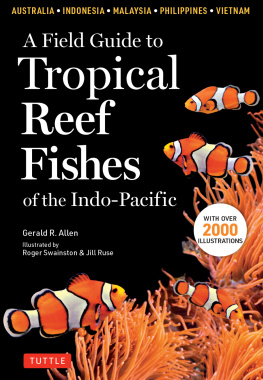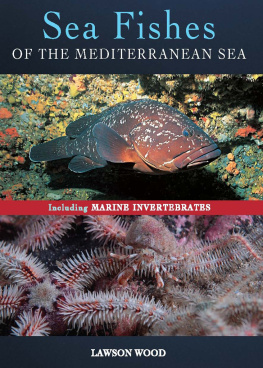David Hallock Secor - Migration Ecology of Marine Fishes
Here you can read online David Hallock Secor - Migration Ecology of Marine Fishes full text of the book (entire story) in english for free. Download pdf and epub, get meaning, cover and reviews about this ebook. year: 2015, publisher: JohnsHopkinsUP, genre: Romance novel. Description of the work, (preface) as well as reviews are available. Best literature library LitArk.com created for fans of good reading and offers a wide selection of genres:
Romance novel
Science fiction
Adventure
Detective
Science
History
Home and family
Prose
Art
Politics
Computer
Non-fiction
Religion
Business
Children
Humor
Choose a favorite category and find really read worthwhile books. Enjoy immersion in the world of imagination, feel the emotions of the characters or learn something new for yourself, make an fascinating discovery.

- Book:Migration Ecology of Marine Fishes
- Author:
- Publisher:JohnsHopkinsUP
- Genre:
- Year:2015
- Rating:3 / 5
- Favourites:Add to favourites
- Your mark:
- 60
- 1
- 2
- 3
- 4
- 5
Migration Ecology of Marine Fishes: summary, description and annotation
We offer to read an annotation, description, summary or preface (depends on what the author of the book "Migration Ecology of Marine Fishes" wrote himself). If you haven't found the necessary information about the book — write in the comments, we will try to find it.
Migration Ecology of Marine Fishes — read online for free the complete book (whole text) full work
Below is the text of the book, divided by pages. System saving the place of the last page read, allows you to conveniently read the book "Migration Ecology of Marine Fishes" online for free, without having to search again every time where you left off. Put a bookmark, and you can go to the page where you finished reading at any time.
Font size:
Interval:
Bookmark:
Migration Ecology of Marine Fishes
David Hallock Secor

2015 Johns Hopkins University Press
All rights reserved. Published 2015
Printed in the United States of America on acid-free paper
9 8 7 6 5 4 3 2 1
Johns Hopkins University Press
2715 North Charles Street
Baltimore, Maryland 21218-4363
www.press.jhu.edu
Library of Congress Cataloging-in-Publication Data
Secor, David H., 1960
Migration ecology of marine fishes / David Hallock Secor.
pages cm
Includes bibliographical references and index.
ISBN 978-1-4214-1612-0 (hardcover : alk. paper)
ISBN 978-1-4214-1613-7 (electronic) ISBN 1-4214-1612-3
(hardcover : alk. paper) ISBN 1-4214-1613-1 (electronic)
1. Marine fishesMigration. 2. FishesMigration. I. Title.
QL639.5.S43 2015
597.1568dc23 2014018367
A catalog record for this book is available from the British Library.
Special discounts are available for bulk purchases of this book. For more information, please contact Special Sales at 410-516-6936 or .
Johns Hopkins University Press uses environmentally friendly book materials, including recycled text paper that is composed of at least 30 percent post-consumer waste, whenever possible.
To my dad, and his example of contemplative scholarship
Chapter 1
Introduction: The Hidden Lives of Marine Fish
Chapter 2
Bird and Fish Migration: Movement Ecology as a Comparative Framework
Chapter 3
Mating Systems and Larval Dispersal
Chapter 4
Complex Life Cycles and Marine Food Webs: Migrating through Size Spectra
Chapter 5
Population Structure: Closed and Open Life Cycles
Chapter 6
Propagating Propensities: Partial Migration
Chapter 7
Resilience: Contingents for Contingencies
Vince Burke, executive editor at Johns Hopkins University Press, asked me several years ago, Why not write a book? Years earlier, my then-5-year-old son posed a similar question: Moms running marathons. Why dont you? Unfortunately, endurance running and writing cannot be sustained by the why not motivation. My motivation to write this book was largely selfisha chance to sit in quiet scholarship and try to make sense of an era of discovery on fish migration. My career (1983present) spans the information age, which has generated a flood of empirical and modeling advances during a period of strong public and private support for marine science. We now find ourselves in the happy dilemma of being deluged in discovery. My goal was to sample recent discoveries and place them into common themes related to life cycle diversity. The inspiration came from my dog-eared volume of Fish Migration, a thesis on the life cycles of marine fishes written by F. R. Harden Jones more than 40 years ago. Could I build on where Harden Jones left off?
I wrote most of this book at the James P. Muldoon River Center at St. Marys College of Maryland, hosted by Bob Paul and the Department of Biology. Chesapeake Biological Laboratory Directors Margaret Palmer and Tom Miller and the University of Maryland Center for Environmental Science President Don Boesch were quite supportive in accommodating periodic absences to work on the book. I am indebted to the members of my laboratory over the past several years, who have endured my frequent absences. In particular, Alex Atkinson, Ben Gahagan, Mike OBrien, and Matt Siskey have helped hold down the fort. Librarian Kathy Heil kept me out of hoc with late-returned books, and Mike OBrien obligingly put together most of the maps appearing in the volume. Sara Rains provided fish and bird artwork appearing in ).
Lots of contemplative quiet hours at St. Marys College may sound a bit lonely, but in fact there was a constant din of voices from colleagues as I visited (or revisited) their work. I am privileged to work amidst an incredibly active and prolific cohort of scientists, whose enthusiasm for unraveling the hidden lives of marine fishes is inspiring. I have tried to listen to what they have had to say and hope that I have given their voices due reflection. Most influential, however, were my own former students: Lisa Kerr, Richard Kraus, Edwin Niklitschek, and Ryan Woodland. The daily interactions of supervising them as past PhD students have opened doors, heightened my awareness, and helped me witness new discoveries that I would have otherwise missed. Likewise, many friends and colleagues have helped shape this book. Foremost in motivating me were book writers Ken Able and John Waldman, who provided large footsteps to follow. Influential conversations (albeit during sometimes brief interactions) shaped this book, including those with Ken Able, Andy Bakun, Steve Berkeley, Barbara Block, Denise Breitburg, Deirdre Brophy, Steve Cadrin, Greg Cailliet, Steve Campana, John Casselman, Dave Conover, Ad Corten, Chuck Coutant, Bob Cowen, John Mark Dean, Julian Dodson, Dewayne Fox, Jean-Marc Fromentin, John Graves, Mart Gross, Sharon Herzka, Robert Humston, Karin Limburg, Molly Lutcavage, John Manderson, Jim McCleave, Ian McQuinn, Tom Miller, John Neilson, John Olney, Pierre Petitgas, Adrian Rijnsdorp, Alexei Sharov, Mike Sinclair, Susan Sogard, Masaru Tanaka, Katsumi Tsukamoto, Bob Ulanowicz, John Waldman, Paul Webb, and Mike Wilberg. I am particularly grateful to my long-term collaborators Ed Houde and Jay Rooker for their friendships, unique takes on the world, and abiding support of my scientific pursuits.
Finally, I thank my nature-enthusiast mom and wife, Eriko, who understands all about endurance sports.
Migration Ecology of Marine Fishes
Animal migration is a phenomenon far grander and more patterned than animal movement. It represents collective travel with long-deferred rewards. It suggests premeditation and epic willfulness, codified as inherited instinct.
David Quammen (2010)
Imagine the clandestine lives of marine fishestheir migrations, affinity for habitat, social interactions, and pursuit of preyall obscured below the seas oft-opaque surface. The lives of marine fishes have long inspired frustration, wonder, and creative impulse among naturalists, fishermen, scientists, and writers. Two generations ago, visionaries Jacques Cousteau, Rachel Carson, and Eugenie Clark dramatically expanded our view of the dynamic seascapes and the fish that inhabit them. Their technical and literary breakthroughs, passion and creativity generated a wave of public enthusiasm for undersea exploration and catalyzed a generation of marine scientists dedicated to making seascapes and the lives of marine fishes ever more overt. The result is an unprecedented period of discovery arising from advances in ocean observing systems, in methods to track individual fish movements, and in computing and telecommunications systems designed to detect, summarize, and simulate fish migrations. The Census of Marine Life is but one, albeit grand, example: a 10-y program (19902000) of exploration resulting in hundreds of expeditions, >6,000 new species descriptions, and countless newly described fish migrations and life cycles (Snelgrove 2010).
Next pageFont size:
Interval:
Bookmark:
Similar books «Migration Ecology of Marine Fishes»
Look at similar books to Migration Ecology of Marine Fishes. We have selected literature similar in name and meaning in the hope of providing readers with more options to find new, interesting, not yet read works.
Discussion, reviews of the book Migration Ecology of Marine Fishes and just readers' own opinions. Leave your comments, write what you think about the work, its meaning or the main characters. Specify what exactly you liked and what you didn't like, and why you think so.







